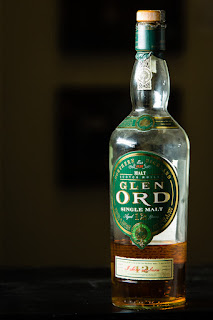 So you're in the liquor store, looking for a gift for friend who likes Irish whiskey, and you spot the bottles of The Irishman Founder's Reserve, and you go "Hey, something new - I bet so-and-so will love it!"
So you're in the liquor store, looking for a gift for friend who likes Irish whiskey, and you spot the bottles of The Irishman Founder's Reserve, and you go "Hey, something new - I bet so-and-so will love it!"You'll want to check yourself right there and ask: "Does so-and-so like whiskey, or does so-and-so only particularly like the 'standard Irish whiskey'?"
Because while TIFR is a whiskey from Ireland, and it is triple distilled like other Irish whiskey's, it's flavor profile is not that of the "standard Irish whiskey" as codified by Jameson's, Tullamore Dew and the like.
The flavor reminds me more of a light single malt scotch. There's more weight to the mouthfeel and more oak to the flavor than I associated with the "standard Irish Whiskey" flavor profile.
Part of how they get that flavor is in the distillation process, as they distill everything - the barley malt whiskey and the other grain whiskies that make up the final blend, in pot stills. Normally, the non-barley malt whiskies get run through a continuous still, which creates a different flavor profile from a pot still (pot still may capture/produce more esters) as well being able to distill to a higher alcohol concentration. From the company website:
"The proportions used are 70% Single Malt and 30% Single Pot Still...the only Irish blended whiskey to contain 100% whiskey distillates from the copper pot still..."
The careful reader will note that the don't actually say what's in the mash for that 30% single pot still whiskey. A careful reader will also wonder at this statement "...a blend of two styles, Single Malt and Single Pot Still", which frankly seems like deliberately obfuscatory marketing mush. Because, you see, in this case only difference between the styles is in the mash, not the still.
Reading through the company site a little more, one discovers a very American Bourbon touch to the operation: the actual whiskey is distilled for them under contract by Irish Distillers. This type of arrangement is common in the US, where there is a huge proliferation of bourbon brands, but only a small number of actual distilleries producing the raw spirt. That said, there's ample proof that this approach can work well - it's what the makers of Angel's Envy and Hirsch Small Batch Reserve Bourbon do, and they turn out a superior product. And definite bonus pounts to "The Irishman folks for being up front about it, instead of hiding behind a cloud of marketing BS the way Anchor Distilling does with the Hirsch Small Batch Reserve.
TIFR, once it finishes the marketing confused distillation process, is aged in ex-Bourbon casks for an unspecified period of time, before the casks are married together. The resulting spirit is watered down from cask strength to 80 proof (40% abv) for bottling.
Neat, the nose is astringent. With a splash of water, that resolves into oak with some dashes of sweetness, but still the astringency remains.
Colorwise, TIFR weighs as a darker amber than the Jameson's and Tullarmore Dew's of the whiskey world.
As mentioned before, though, the flavor is where TIFR departs most radically from the "standard Irish whiskey" script. The sweet notes that start the dram don't last long before being taken over by pepper and oak that hang on for a reasonably long finish. For tongue expecting the sweet simplicity associated with most Irish whiskey, the spicier nature, more complex flavors and slightly heavier mouthfeel of TIFR is a real surprise.
If you like your whiskey with a bit of punch to the flavor, and find the standard Irish whiskies on the shelf a bit too one dimensional, The Irishman Founder's Reserve is worth a try. Likewise, if you prefer the complexities of single malt scotch, but are looking for a Irish whiskey to put on your bar for variety, you should give The Irishman Founder's Reserve a shot. At under $30 a bottle here in the US, it's a decent value for your money.
Now that I have given it a fair shot - I think an 750ml bottle consumed over several months counts as a fair shot - I'm probably not going to stock in on my bar. I have plenty of single malts for complexity, a mess of bourbons and ryes for variety, and what's missing right now is the simple and sweet counterpoint of a standard Irish whiskey.












